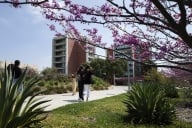You have /5 articles left.
Sign up for a free account or log in.
Few topics in higher education policy recently have received as much attention as the connection between education and work. In the past month, I’ve been to meetings where stakeholders in work-force policy bemoan the irrelevance of higher education, while higher education leaders cry that they are not in fact irrelevant, merely misunderstood. We need to find a middle ground.
Several state and federal policies exist in that middle ground, such as work-study programs. Work-study allows mainly undergraduate students to work in certain on- or off-campus jobs and earn a paycheck at regular intervals. The amount students can earn is capped. And while the money does not directly deduct from a student’s bill for tuition and fees, the maximum amount of their earnings for the year counts as need-based financial aid in the student’s total aid package. An added bonus is that, on the next year’s aid application, students do not have to report earnings from work-study as income. This allows students to earn a regular paycheck while enrolled without impacting eligibility for need-based aid in the following school year.
Full disclosure: I completed my undergraduate degree with continuous support from both federally funded and state-funded work-study. While the content area of my employment was unrelated to my degree program, my lived experience in the program informs my belief that work-study is valuable and can be transformative for students seeking skills to succeed in the world of work. This belief is reinforced by research.
A new experimental site proposed by the Secretary of Education Betsy DeVos intends to strengthen the connection between what students are studying and the work they do in their work-study positions. This experiment will allow students in participating postsecondary institutions to earn work-study dollars at a broader set of off-campus employers, including for-profit companies. It also will require that off-campus employers chip in a smaller share of the student’s earnings. Finally, it will allow students who are eligible for work-study to earn their awards through externships, clinical rotations or student teaching.
I’m not interested in critiquing the experiment on its merits; institutional aid offices remain the ultimate arbiter of which employers can participate in work-study and how. Under current policy, we trust those administrators to partner with on- and off-campus employers that meet the requirements of the law, and, ideally, their student workers as well.
What I am concerned about is that the formula currently employed to distribute work-study will kick this experiment in the kneecaps. Arguably, the institutions that are best positioned to provide highly connected work and learning experiences are those providing the most specialized types of education: our nation’s two-year colleges. The trouble is the allocation formula for federal work-study cripples these institutions’ ability to provide work-study to their students.
Take, for example, the state of Massachusetts, where only a quarter of the state’s allocation of federal work-study dollars was expended in the public sector. The institutions with the largest allocations of federal work-study are all four-year, private institutions: Northeastern University, Harvard University, Boston University and Massachusetts Institute of Technology. Going down the list, you won’t see a two-year institution listed until No. 19: Bunker Hill Community College. Bunker Hill’s share of federal work-study is only 8 percent of what the top four private institutions receive.
Not every state is Massachusetts, but the trend holds: two-year colleges receive only a fraction of what more privileged institutions receive in federal work-study.
The campus-based aid formula that directs the allocation of work-study and other grants has long been criticized for being inequitable. The formula seems trapped in its own inertia -- historical precedent prevailing over fear that changes could mean cuts. And, to be fair, the department can’t change the formula without Congress changing the law.
Moving our nation’s privileged institutions toward greater convergence with work-force needs may be a laudable goal of this experimental site. However, there is already a well-established sector of American higher education that would rise to the occasion to strengthen these linkages -- and that, in many cases, already does it with the fraction of support they are provided. I’ll certainly watch the outcomes of this experiment. But I’ll take it all with a grain of salt until the formula actually follows one of our nation’s strongest talent pipelines.








